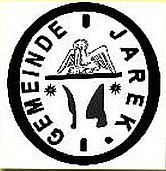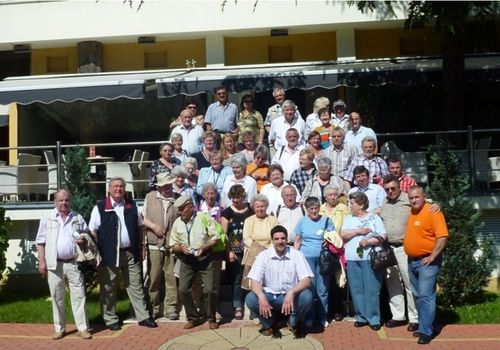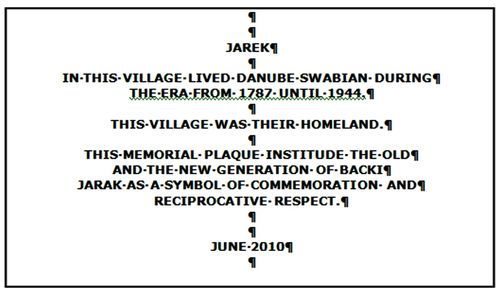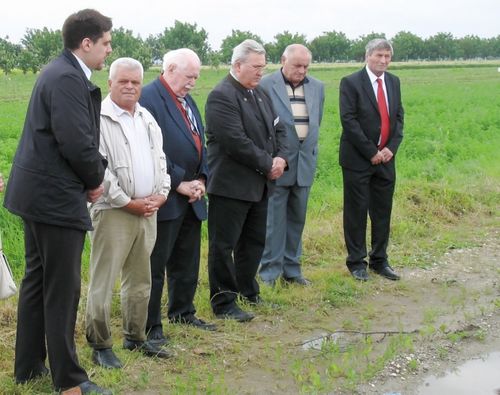Report of the Jarek Trip in June 2010
Report of the Jarek Trip from June 3th till June 8th, 2010
organized by OA Jarek (Orts-Ausschuss: committee)
Tour-guides: Inge Morgenthaler and Michael Rettinger
Picture 1 - The Jareker group in front of the “Parkhotel” in Novi Sad. Second from
the left side: Michael Rettinger, to the right: Michael Schmidt, 2 to the right and
1 upstairs: Inge Morgenthaler, ahead in the crouch: “Benni” our tour guide
and rightmost: Dragan our bus driver, both from Novi Sad (Serbia).
It was a diverse group of 42 persons who turned up at the airport inStuttgartonJune 3, 2010to fly from there toBelgradeand to visit Jarek from there. A third [of them] belonged to the age groups 1927 to approximately 1935. They had still lived in Jarek as young people and they wanted to renew their memories and see their home again. A further third between the age group 1937 and 1944 was, of course, born in Jarek, but had yet only faint memories of the village or even none at all anymore. Most of this group came with their spouses, who weren’t from Jarek. The last group finally was the post-war generation, who only knew Jarek from the stories told by their parents and grandparents, and who wanted to see where they had lived. How would all of these diverse people fit together? Would this work out?
We were received inBelgradeby a young tour guide from the firm of Elnostours,Novi Sad, who had graduated from high school inBerlinand therefore spoke German perfectly. The concern Elnos Tours had organized this trip according to my plans. Michael Rettinger had taken care of the financial part of the trip.
We arrived at the Park Hotel inNovi Sadafter a pleasant journey, where we obtained our rooms. It belongs to the five best hotels inSerbia. After we had freshened up somewhat, we rode in our bus to the city center. At the National Theater the city tour began through a pedestrian zone. All were impressed by the large square in front of the magnificent city hall, the recently renovated Catholic church and the beautiful old art nouveau houses roundabout.
During a stroll through the pedestrian zone in the direction of the bishop’s palace, we were able to admire further art nouveau houses. TodayNovi Sadis a very lively city. In nearly every house on this street there is café or a restaurant with tables and chairs in front. The lower pedestrian zone in the direction of the Donaupark (DanubePark) has been especially nicely renovated. There are small passages with modern stores, which were all open notwithstanding the holiday.
Following the city tour, we ate our supper in a very beautiful old traditional restaurant at a side street. We received an excellent menu and a goodBanatwine. The bus took us back to the hotel again later, and we spent our first nigh there.
On Friday, June 4th after a good breakfast buffet with much Serbian sausage and cheese specialties, the great event was to take place in Jarek, for which we had waited for nine years: The unveiling of a memorial plaque in the village hall. (See the report: Commemorations in Jarek.) Our bus finally took over the canal to the road to Jarek. Here we rode through the lowlands of the Batschka to our home village, the most important destination of our trip. All those who had known it previously, it seemed strange.
The old houses in the lower Hauptgasse on the left side have nearly all been torn down and replaced with new ones. On the right side some are yet standing, but partially with hideous additions. In the former “Großen Wirtshaus” (“Large Inn”) there is a pharmacy, next to it, a flower shop. Behind it is a new Orthodox church.
Before dinner we had the opportunity to gain a first impression of the village. We strolled in small groups through the town — [having been] provided with copies of the old and new town map, in which also the small streets between the gardens are sketched in — which are all built-up with new houses. Backi Jarek has about 8,000 inhabitants today.
Since our visit in the year 2006, several very beautiful new businesses have emerged. Also in the upper Hauptgasse the stucco of several facades have been renewed and the houses have been painted with colorful paints. It struck me that the houses newly renovated in the year 2006 have lost their color again in the meantime. It was explained to me that the paint gets ruined by the “Saliter” (“saltpeter”) which is absorbed by the façade from below. It was not for nothing formerly that the women of Jarek whitewashed the houses every year before “Kerweih.”
In the afternoon we strolled again through the village. We were able to go into every yard and we had the impression that the people were waiting for us. They greeted us kindly and would have liked to talk with us more, which regrettable failed due to the language. Most of the old transverse houses in the Haupt- Spital- und Wassergasse are belong to two owners. Often one half of the façade is renovated and the other half is run down. We also saw several fences which cut through exactly the center of the old yards and gardens. The old front-buildings are mostly rented out and the owners have added new houses in the yard where formerly were the arbors and stables.
In the evening we drove to Cenej to eat at a Gäste-Salash. Unfortunately we could not sit under the beautiful old nut trees since it rained in torrents. But the inside was still docarated in the old style, and we spent a cozy evening.
Also on Saturday a visit to Jarek was scheduled. This time I went into the houses of my grandparents and was received very kindly. They welcomed my cordially and asked me to absolutely to come again for a longer stay.
We ate dinner in the large inn in the Kreuzgasse both days. Our travel agency had organized a “Banda” (a folklore music band) on Friday and on Saturday a young folk dance group, which performed Serbian dances and songs. The beautifully dressed young men and maidens took great pains and were delighted by the nice tip.
After that we drove to Temerin to the “Bean-Soup World Championship,” to which Mr. Mandic as well as the mayor of Temerin, Mr. Gustonj, had invited us. It was a noisy and entertaining folk festival.
Therefore we arrived somewhat later at the Peterwardein Fortress. The façade of the restaurant there has been recently renovated; the photos of the bombedDanubebridges have been taken down, and the people ofNovi Sadenjoy life. All tables on the large observation terrace were occupied. We also enjoyed our supper with a view of the passing ships on theDanubeand of the setting sun, of course, again with a goodBanatwine.
We also wanted to see something of the Vojvodina in deed and I therefore had planned a ride into the Fruska Gora for Sunday. We crossed theDanubeover the new bridge, which was build with EU moneys and opened in 2006; we rode through the Kamendin with the villas of the wealthy Serbs, after that through the woods of the national park until the monastery New Hopovo. Of the former 35 Serbian-Orthodox monasteries only 17 are still extant. These monasteries with their ancient frescos and Iconostases rank among the most beautiful inEurope. Also the next monastery, Krusedol, was freshly renovated and made a very inviting and pleasant impression. Our trip continued then through vineyards and fruit groves down to theDanube, which lay before us as a mighty wide stream until Srenski Karlovci.
In the new restaurant “Dunav” directly at the bank of theDanubeseating for us had been reserved. We were able to experience the passing tow and push boats really up close. Due to the many heavy rains there was flooding, and the wide Danube Stream impressed us very much.
For wine and honey sampling we strolled in a cozy garden into the honey museum at the other end of the town. We were already the zillionth group on that day and bread had run out. The renowned Riesling, which the Romans had already cultivated in the Fruska Gora, would have tasted better with some bread. In any case, we could not take any along, but for that we bought the magnificent acacia honey of the gigantic trees behind the house.
On the return trip toNovi Sadwe drove by the church “Maria Schnee” and made a short stop. It is the famous pilgrimage church of the Catholic Danube Swabians, which was built at the spot where Prince Eugen had defeated a Turkish army onAugust 5th, 1716, which was many-times of superior strength. Snow was to have fallen which crippled the Turks because they believed it to be a miracle.
Our tour guide after that took us to a brand spanking new super-modern fish bar on the Fischerinsel inNovi Sadin the shape of a ship. Here we received an outstanding fish soup and batteredDanubefish. Also from here we could see the passing boats very near, because the water reached nearly to the house or rather to the ship. After this diversified day we arrived red at our hotel, ready for our last night inNovi Sad.
The next morning signified the leave-taking fromNovi Sad, but before that we visited the Piaz (market) to do the last shopping and to buy hand-made delicious noodles, which can be bought only there. After that our bus drove on the Autobahn through the far lowlands of the Batschka, over the wideDanubeBridgenear Baja tillBelgrade. The new local city guide took us first to the fortress Kalemegdan, where we had a magnificent view of the confluence of the Save andDanube. From there we strolled through the splendid boulevards of the pedestrian zone, passed the national theater and museums to the restaurant. These houses, too, were beautifully renovated, but the views into the side streets revealed a different picture. There is yet endlessly much to be done in this city. “When we enter into the EU everything will be different,” is what many people say.
After dinner, which we could hardly master, we made a city tour, passing by the bombed buildings of the last war, which had been left standing. Our tour ended with the viwieng of thechurchofSaint Sava, the national saint of the Serbs. Here ended also the ability to walk of our dear Michael Schmidt. He broke several toes at the last quarter hour, which however, did not prevent him from an evening of entertainment the last night at the hotel. He let rain down upon us a “firework” of poems, songs in three languages and anecdotes that was just a pure delight.
The following morning the bus took us to the airport, where we said good-bye to our tour guide, Benny, who took care of us every day until late at night; who interpreted for us, and who saw to it that all instructions of his boss, Alexander Vranic, were carried out just as I had discussed with him. Everything has gone splendidly without a hitch, and the travel bureau Elnos Tours has labored to our fullest satisfaction.
It became apparent very quickly that despite the great age differences all participants got along markedly with each other and constituted a harmonious group. As I was told, all were very pleased with the trip. For most of them this will probably have been the last journey to the old home; but some said that they will travel there again when the memorial plaque at the mass graves will be dedicated.
Inge Morgenthaler
translated by Sieghart Rein
OA Jarek, in June 2010
__________________________________________________________________
Download for the "pdf-file":
__________________________________________________________________
Commemorations in Jarek
during Jarek Trip from June 3th till June 8th, 2010
organized by OA Jarek (Orts-Ausschuss: committee)
Tour-guides: Inge Morgenthaler and Michael Rettinger
On the day of our arrival,Friday, June 4th, 2010, the group of Jarek travelers rode fromNovi Sadto Jarek after breakfast.
The bus stopped in the center of the village in front of the community house [village hall]. We were awaited by the chairman of the Jarek community council, Mr. Mandic, and the secretary of the community, Mr. Mrdjen; and they accompanied us into the house. At the door we were greeted, according to an old Serbian tradition, by a girl in peasant costume, with bread and salt.
In the large council room chairs were ready for all. Several community councilors and citizens of Backi Jarek had come in order to attend this occasion. Mr. Mandic welcomed us with a short speech and wished us a pleasant stay.
Our 1st president, Michael Schmidt, replied to him with a speech given in Serbian, which Michael Rettinger, our 2nd president, then read in German.
In his speech Michael Schmidt reported that he at the head of a group of Jarekers, whose children and spouses had come to Jarek, in order to satisfy our yearning, which is characteristic of every human, namely to see his home again, and also if possible, to see the houses in which one had once lived.
He emphasized explicitly, that we have come as guests and tourists and in no way is it our intention to assert any claims. Our aim is simply to refresh old memories and to show our children where we had lived with our Serbian and Hungarian neighbors as peaceful citizens throughout generations. After the bitter years of the war and the post-war years we all had built up a new existence in our new homelands, and we and our children and grandchildren are completely integrated there after 65 years. But our old home is very dear to our hearts. Thus it is a special joy that we succeeded, after many years, to be able to affix a plaque to the community house, which is a reminder of our presence in Jarek. By mutual understanding a text has been agreed upon, which would do justice to both sides.
After that he asked that all should cherish the plaque and not tolerate any abuse. It is a part of the history of this village.
Following this speech all went to the hallway in front of the plaque covered with a purple cloth. Michael Schmidt and Mr. Mandic together pulled the cloth to the side and we could see the plaque for the first time. It has really turned out very beautiful. We were allowed to add our say for the design; for the text we had guidelines which we had to adhere to. For us Jarekers a great desire was fulfilled by this plaque.
It was planned and created only through the personal effort of Michael Rettinger with the help of federal chairman of the Danube Swabians, Hans Supritz, in the time of four months. On site the head of the deaconry inNovi Sad, Mrs. Bu, coordinated all work. We are very grateful to all of them.
Picture 1 - (for enlargement: click on the photo) The Jarek Commemorative
Plaque in the foyer of the community house in Bački Jarak. Under the
community emblem of Bački Jarak (on the left) und Jarek (on the right)
there is in each case the same text in Serbian and in German language.
Picture 2 - The Jarek Commemorative Plaque reads:
Picture 3 - (from the left) Mr. Mandic, Inge Morgenthaler,
Michael Rettinger and Michael Schmidt in front
of the new Jarek commemorative plaque.
After the unveiling of the plaque our bus drove with Mr. Mandic and Mr. Mrdjen out to the tentative memorial site for the mass graves. It had rained for days and the small hill with the cross was surrounded by an area of water. Next to it was a wild garbage dump. It was therefore not possible to put down our wreath. We stood there helpless in front of the “lake”. Rescue arrived via a brave citizen of Bački Jarek, an acquaintance of the Rieß family. He waded through the “lake” and fastened the wreath to the cross. We all were very grateful to him for it.
He waded through the “lake” and fastened the wreath to the cross. We all were very grateful to him for it.
On solid ground near the bus, Michael Schmidt was able to begin with the commemoration for the death of the internment camp.
He first read a poem by the Budisava regional poet, Johannes Wurz, who was originally from Jarek, which suited the occasion well. In connection to that he remembered, in moving words, the 6,500 innocent death, 950 children among them, who had lost their lives due to hunger and diseases, and who were buried in mass graves near this temporary memorial site. He pointed out that Mr. Supritz of the Federal Association of Danube Swabians has worked many years on the erection of an appropriate memorial where the descendants of all those who perished in the internment camp can say their prayers and place flowers and wreathes.
The small ceremony was concluded with the joint recitation of the “Our Father.”
Perhaps this commemoration at the edge of the water surface in undeserving surroundings will finally convince the authoritative people of Backi Jarek to provide a parcel of land that’s better suited.
Picture 4 - During the commemoration for the casualties from
the Jarek death camp: (from the left) our tour guide “Benni”,
the “brave citizen” of Bački Jarak, Michael Schmidt,
Michael Rettinger, Mr. Mrdjen and Mr. Mandic.
After a stroll through the village all of us met in the largeInnin the Kreuzgasse. An entire table was occupied by members of the Council of the Community of Backi Jarek, who had heeded our invitation for dinner. Several Temerin Community Councilors present.
We presented the representatives of the community our presents, the latest Heimatbücher, a village map, and a picture of thechurchofJarek. Beyond that the participants of the trip had donated a considerable sum for the kindergarten.
There is no comparison to our previous visit with theDanubeship, when we waited over an our in front of the community hall, but none of the “officials” could be disturbed form his Sunday rest.
This time we had the feeling that the “ice age “between the old and new Jareker has ended, and we are reciprocally moving closer to each other.
This was affirmed by the invitation of the community to the “Bean soup championship,” which was to be on Saturday in Temerin. Although we actually had different plans, we decided to accept the invitation. Mr. Gustonj, the mayor of Temerin, was also among the participants in the competition. He had reserved places in a tent for our group and the representatives of Backi Jarek. As we found out later, this was definitely not to be taken for granted. Are we to have possibly contributed to improving the relationship of the two districts of the village?
Inge Morgenthaler
translated by Siegbert Rein
OA Jarek, in June 2010
_____________________________________________________________________________
From the Jarek Trip, from June 3th till June 8th, 2010, with dedication the Jarek Commemorative Plaque in the community house in Bački Jarak and the Commemorations in Jarek close to the “provisional memorial” for the more than 6.500 casualtys in the internment camp Jarek (1944 til 1946), you can “click” to view 28 pictures in a "Picture-Galery". The text below the pictures is regrettably only in German language. --->
---> To this “Picture Galery“ and the “pdf-data file“ with the 28 pictures you can get on the next page: “Picture-Galery: Jarek Trip – and Commemorations in Jarek - June 2010”.
.
__________________________________________________________________
Download for the "pdf-file":
__________________________________________________________________





